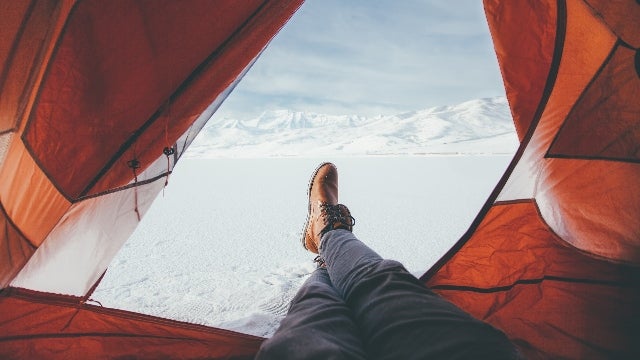Conditioning Yourself for Cold-Weather Camping: What to Expect
Martin Banks 01.17.24

Many people roll up their tents for the winter, making cold-weather camping one of the best ways to explore the great outdoors free from the madding crowds. Even popular campsites quiet down over the holidays, and boondocking is the sole reserve of hunters and other rugged outdoor enthusiasts. However, there’s a good reason many people hibernate for winter. Freezing temperatures bring unique dangers for which you must prepare. Here’s your crash course on what to expect and how to condition yourself for cold-weather camping.
Camping Coverage on AllOutdoor
- Burning Bushcraft – The Best Firestarters for Camping in 2023
- AllOutdoor Review – The Best Overnight Backpacks for Camping in 2023
- AO Review: Estwing Sportsman Axe – Only Camping Chopper You Need
- The Path Less Traveled #070: Stealth Camping, Ever a Good Idea?
What to Bring
Your first order of business in cold-weather camping is staying warm. Hypothermia can occur in temperatures higher than 40° Fahrenheit, and your worst nightmare is going to sleep and not waking up. That means gearing up with the right supplies.
For Tent Campers
You’ll need a tent — the smaller, the better. Confined spaces warm up more quickly, courtesy of your body heat. However, you can help matters along by bringing two tarps — one to place over your tent and another for beneath it. The bottom one insulates you from the cold earth, while the top one covers tiny ventilation holes, keeping the interior warmer. Position your tent to buffer it from chill winds, placing the opening in the opposite direction and using natural barriers like trees or even piled snow banks as windbreaks. An additional raised pad provides extra insulation between you and the ground if icy or snowy conditions predominate.
Your sleeping bag should be slightly “too warm.” What does that mean? If you expect the temperatures at your campsite to average between 25° and 30° Fahrenheit, get a goose-down model rated to 15° F to ensure comfort. Opt for subzero bags if temps dip into the teens. Finally, fire can save your life when cold-weather camping. Please don’t rely on waterproof matches or lighters alone. Learn to master a ferro rod before you go and practice on wet wood to build confidence in your ability to start a blaze anywhere, under nearly any conditions.
For RVers
RVers have more protection when winter camping, but those thinly insulated walls can make you chilly quickly. Furthermore, temperatures can freeze pipes in a heartbeat — there goes your water supply. Take the following precautions before winter camping in your RV:
- Wrap your pipes: You can find special insulated heat wraps made for RVs that prevent pipes from freezing. They are pricey but infinitely less so than buying a new water pump after every outing.
- Skirt your carriage: A lot of cold comes from beneath your rig.
- Check your tires: And the weather report to prevent getting stuck.
Pro-tip: Always carry a shovel and kitty litter when cold-weather camping to help dig your car out if weather happens while in the wild.
What to Wear
Appropriate clothing is also key to staying toasty and protecting against frostbite. Here’s what to do.
How to Layer
- First layer: Consists of a wicking fabric like merino wool, silk or a synthetic blend. Keeping the sweat away from your body is paramount to preventing chills.
- Second layer: Insulate. Pile on the fleece and flannel.
- Third: Weatherproof. Look for something to repel snow, rain and wind.
Accessories
- Hat: You lose about 10% of your body heat through your head.
- Socks: Layer them like clothes to prevent frostbite.
- Gloves and scarf or balaclava: Protect your fingers and neck.
- Boots: Ensure you have sufficient tread for icy surfaces and waterproofing against snow, rain, and accidental steps into the creek. Add metal cleats for more traction.
How to Prepare
Preparing for cold-weather camping is twofold. If you plan on going deep into the wilderness on a hunt, do a trial run in a more favorable location first. It will let you hammer out any issues with your equipment and build confidence in your skills. Secondly, be smart. Always tell someone back home where you’re going and when you anticipate returning. It’s wise to establish check-in times so folks can call for rescue if they don’t hear from you. Time stretches mighty long when freezing and awaiting help. You might also consider a satellite signaling device such as a Garmin if you head to places with unreliable coverage. Although they cost approximately as much as a new gun, they can be just as instrumental in saving your life.
How to Stay Warm in the Woods: Quick Tips
The following quick tips can keep you warmer on your cold-weather camping trip:
- Keep moving: Chop wood, hike and keep that blood flowing for warmth.
- Use a pee bottle: Going out at zero-dark-thirty isn’t fun, especially in winter. A bottle or special device for women preserves nighttime comfort.
- Bring your camp mug: Warming your inside raises your core temperature, so sip hot tea or cocoa.

Cold-Weather Camping Conditioning Tips
Cold-weather camping allows you to enjoy splendid silence and solitude in nature. However, you must protect yourself from the elements. Use these tips to condition yourself for your winter adventures and enjoy your active, outdoor lifestyle any time of the year.